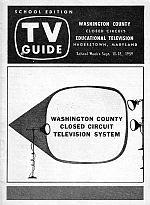
50 YEARS OF INSTRUCTIONAL TELEVISION IN WASHINGTON COUNTY, MARYLAND
A HISTORICAL TIMELINE – 1956 – 2006
( I ) WASHINGTON COUNTY CLOSED-CIRCUIT EDUCATIONAL TELEVISION SYSTEM
1956 –
Superintendent
of Schools, William M. Brish has a vision to experiment with Televised
Instruction.
Ford Foundation sponsors the “Pioneering Experiment”- 2 million dollars, 6- year term.
A Co-axial Cable system is designed by Bell Telephone Corp. and constructed connecting a few schools.
First Telecasts are conducted “Live”– using remote trailer facilities.
Five fully equipped (audio/video) TV Studios are constructed – each with two black and white cameras, two camera operators, one floor manager, two audio-video operators, and one television director.
Mr. T. Wilson Cahall coordinates the television Instruction facilities.
1957 - 1958
Closed-Circuit Cable System is expanded to all Hagerstown area Schools – Employing 20+ Teachers
Mr. Stanley Johnson , and Mrs. Marjorie E. Hoachlander – Television Production Supervisors
Triangle Publications (TV Guide) produces a weekly TV Guide for the school district.
Students in all grade levels are receiving “Live”- televised instruction.
Classroom teachers help to write curriculum and assist each student with the classroom lesson.
Instructional graphics are designed by staff artists -- 16 mm films, photographs and slides enhance televised instruction.
Additional
Televised Courses, Teachers, Television Directors, audio/video studio production
Crewmembers are employed.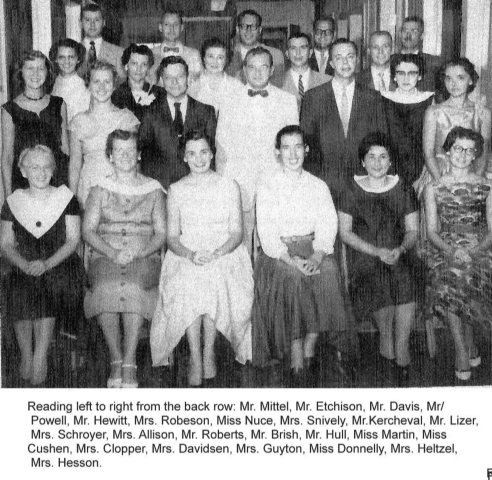
Hagerstown Junior College Students, enrolled in the “Communications Course” are employed as part-time Crewmembers at the television studios.
School students learning skills/abilities are evaluated.
Ampex, Corp. donated a 2-inch VideoTape Machine to the TV Center. – some telecasts are videotaped for teachers to evaluate themselves, and for archival purposes – not for transmitting at this time.
1959 – 1963
The Closed-Circuit Television Network is completed – connecting all district schools.
Mr. Robert F. Leasure coordinates the television Instruction facilities
Mr. George Ropp is Principal of Television Teachers and supervises the Graphic Arts Support Staff of (3)
Mr. Sam Wagaman – Assistant Television Production Supervisor.
Mr. James Spear – joins the Production Supervisor Team.
To
improve the professional quality of Televised Courses - skilled, full-time
personnel are retained and hired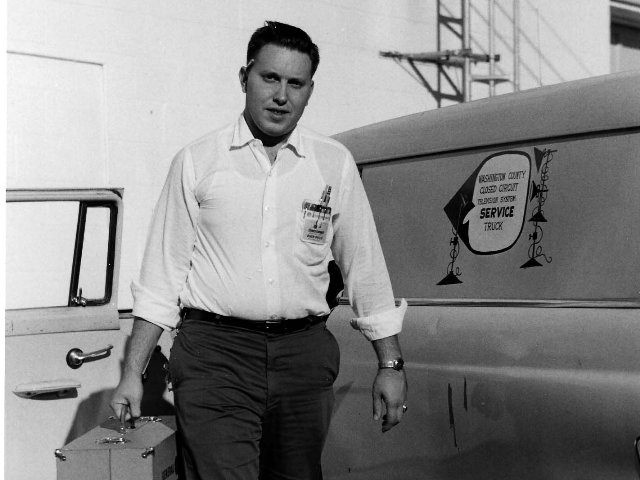
Artists, Photographer, Television Directors and most A/V operators are full-time employed – other part-time college student crewmembers rotate in and out each year.
A Television maintenance and A/V services department is established.
A Clerical staff is added to facilitate the typing of television scripts and publications.
School students - learning skills/abilities continue to be evaluated.
Another 2-inch Ampex Tape machine was donated. – some courses are videotaped and lesson series televised.
Washington County School District now funds the full Educational Television budget.
Bell Telephone Corp. – charges an annual rental fee ($156,000) for use of co-axial cable network connecting all district schools.
Public Taxpayers begin to complain about “costs” of teaching with television.
1964 - 1967
New Facilities (Central Resource Center) are renovated and constructed for Television Teachers, Graphic Arts, Photography, and Printing/Publications personnel.
Air
Conditioning was added to all facilities.
A Television maintenance and A/V services facility is constructed
A new building is constructed for TV Teachers offices.
A 16 mm and still Photography studio and darkroom is constructed.
A Title III (Federal Government funded, 3-year, Project) began to produce 16 mm film productions for instructional purposes, and to produce and evaluate Televised Instruction.
1968 - 1973
Dr. William Brish retires in 1973 after overseeing his successful Television Project for 17 years.
The Resource Center” concept is developed. – Combining Television, Library, Graphic Arts, Photography, and Instructional Materials Departments.
A staff of 30 + Television Teachers continue to produce live and videotaped, lessons for classroom instruction (in black and white format).
A videotape remote camera system is purchased to supplement the productions.
The
Title III project ends in 1970 after a thorough evaluation – finding
that Television is a successful instructional tool for classroom teachers to
use.
teachers to
use.
The public (taxpayers) continue to complain about the growth and costs of “teaching with television.”
1973 - Dr. Claude Kitchens – new Superintendent of Schools, upgrades and restructures the Television Production System.
Citizen Committees evaluate Educational Television System and make specific recommendations for improvements and cutting costs.
Robert Leasure, Coordinator of Television and George Ropp, Television Utilization Specialist retire.
( II ) WASHINGTON COUNTY INSTRUCTIONAL RESOURCE CENTER
1974 – 1979
Mr. Richard Predmore becomes Coordinator of Television and implements changes –
Washington County Closed-Circuit Television becomes - WASHINGTON COUNTY INSTRUCTIONAL RESOURCE CENTER (IRC).
The IRC incorporated the following departments: Instructional Television Production, Television Maintenance, Central Office Library, Graphic Arts, Photography, Instructional Materials Lab, and Printing/Publications Services.
A
system of transporting Videotaped Lessons to and from schools was developed.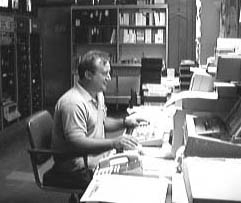
1977 - The Closed-Circuit cable network was no longer needed and was eliminated. – saving $240,000 per year.
1977-1978 Studio Production Equipment was upgraded to “Color Productions.” – a major improvement for instruction. – special effects switcher, Character Generator, color camcorder remote system.
Emphasis was placed on “professional quality productions” and wages were compensated accordingly.
A large number of Video Tape Recorders were purchased to produce and duplicate the instructional lessons.
1978
- Changes in the use of television have also taken place this year. No
longer are programs produced live and no longer is television used in large,
combined classes. Programs are being produced in both color and black
and white. Students today have the advantage of small-group or individual
presentations. Television teacher visitations and a new concept - instant
replay on a videocassette machine - are available. Programs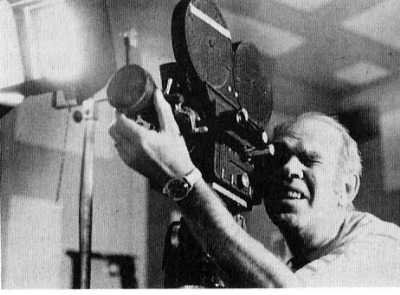 developed in the
television studios are recorded on videocassettes and sent to all schools.
Teachers utilize and control these cassettes in classrooms. Lessons are
telecast to meet the school schedules, but teachers can request replay at
any time.
developed in the
television studios are recorded on videocassettes and sent to all schools.
Teachers utilize and control these cassettes in classrooms. Lessons are
telecast to meet the school schedules, but teachers can request replay at
any time.
A VideoTape Library was established to catalog and retrieve for classroom teachers.
Professional quality was such that local businesses and National Corporations contracted with Washington County to produce custom Videotapes for their use.
An agent was contracted to “Market/sell” our Instructional Lessons Series to other School Districts.
The Library of videotaped Lessons grew to the point that - certain Television Instructors, Administrators, support personnel and (3) Television Studios were no longer needed. – They were reduced each year.
All of the “Predmore” changes seemed to satisfy the “Public Pressure” to reduce the Television budget – thereby, “extending the life” of television production services while improving their quality.
(
III ) WASHINGTON COUNTY INSTRUCTIONAL TELEVISION SERVICES
1980 – 1992
Mr. Richard Whisner – then - Dr. Wayne Gersen becomes Superintendent of Schools
Due to the Department of Instructional reorganization, The IRC terminology is eliminated and each department is incorporated under various management
Mr. William Kercheval becomes Supervisor of Televised Instruction
Television Studio Production, Television Maintenance, Videotape Room Operations, Graphic Arts Instructional Materials come under the “Division of Instructional Television.”
Two large television studios continue to create professional Instructional Television Productions – Elementary Art, Music, Washington County Social Studies and History; Secondary Math, Science, Social Studies, Citizenship, and “Let’s View The News.”(a popular student production)
Television Videotape Remote Crews were formed and used on a regular basis.
Business Contracts were entered with: Washington County Extension Service; The Smithsonian Institute; Dr. Ted Brown, Entertainment Associates; ESOL (English Speakers of Other Languages) and others.
Product
Sales increased until - (20) school districts and (5) State-wide
Networks across the nation repeatedly purchased Washington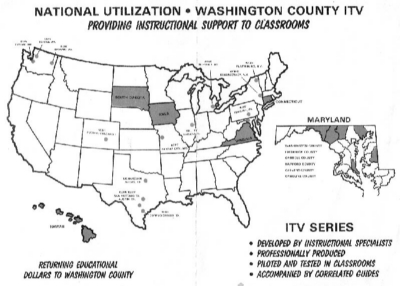 County School District Instructional Television Lesson Packages.
County School District Instructional Television Lesson Packages.
IATV- Interactive Television (two-way televised communication between classroom students and teachers) is begun using microwave/antennas transmissions.
Once again, The Library of videotaped Lessons grew to the point that - certain Television Instructors and support personnel were no longer needed. – They were reduced each year.
1984-1985 A very small ITV staff remains – Two Television Teachers, One TV Director remains. Lesson Series are produced this year and inserted into the curriculum the next year.
Classroom teachers continued to utilize the videotape library on a daily basis but, they no longer requested “new productions.”
The Elected Board of Education began a systematic reduction of television production services for budgetary reasons.
Satellite TV, Maryland ITV, and Cable TV Productions were scheduled for receiving, videotaping and supplying to classroom teachers
William Kercheval retired - thus ending the last of the Studio Television Supervisors.
1988 - Donald Zilch – Director of Instruction, assumes the responsibility of Instructional Television Services.
( IV ) ELIMINATION OF WASHINGTON COUNTY INSTRUCTIONAL TELEVISION SERVICES
1994 –
Dr.
Herman Bartlet becomes Superintendent of Schools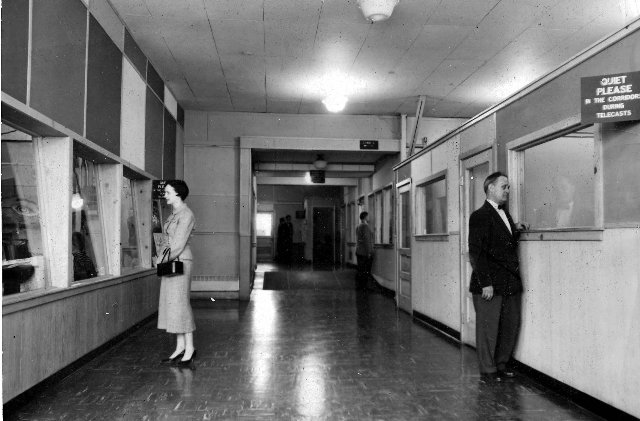
1994 – 1997
Mr. Vincent Tantillo (Coordinator of Audio/Video Services) – assumes Coordinator of Television Services
There appears to be little support for televised instruction from Superintendent Bartlet, the Department of Instruction and the Elected Board of Education.
No updated equipment is purchased
No “new” televised instructional lessons are initiated.
IATV (interactive televised classroom instruction) continues to link all High Schools
Television Maintenance Service and technicians are moved to the “Maintenance Department.”
1997 – 2000
Mr. James Eckel – assumes what remains of Television Services.
“Live” Telecasts of School Board Meetings were produced on a regular basis – using local Cable Television Co. Public access channel.
A few remote telecasts and videotape services continue: - televised Annual Budget meetings, Orientations, Seminars, video yearbooks.
Studio Television Productions become almost non-existent. – The Department of Instruction has little or no interest in producing televised Lessons of Instruction.
Television staff positions are eliminated or transferred to IATV positions in the schools.
Commercial sales of Videotapes are terminated.
Television Studios, Control Rooms and Videotape Rooms are dismantled.
Videotape
Library is severely damaged due to the absence of staff -- and most
original videotaped series are destroyed due to renovation and new
construction in the area.
renovation and new
construction in the area.
2000 – Last staff position is eliminated as Mr. Eckel retires.
2002 – 2006
Dr. Elizabeth Morgan becomes Superintendent of Schools
Mr. Ronald Shirley (reassigned to Library Services) – assumes what remains of Television Videotape Services.
Mr. Shirley, a 30-year Television audio/video operator/technician survives as the only person employed to provide archived and videotape duplications to classroom teachers.
IATV- Interactive Television (two-way televised communication between classroom students and teachers) is now almost inactive. – An Instructional Assistant operates the camera and is assigned to the school principal.
“Live” Telecasts of School Board Meetings continue on a monthly basis – using local Cable Television Co. Public access channel.
WHAT HAPPENED TO INSTRUCTIONAL TELEVISION?
A lack of continuity and understanding on the part of school district administrators and local elected officials failed to preserve former Superintendent William M. Brish’s “Successful Experiment.”
Although numerous studies and evaluations concluded that students receiving televised instruction were consistently ahead of the learning curve, taxpayers in Washington County refused to support it. This forced Elected School Boards to under-fund, thus eliminate, Instructional Television Production.
Once, a National leader of pioneering Instructional Television in K-12 school classrooms - now, the Washington County school district shows no evidence that a skilled staff of hundreds, operating five television studios, for a period of over forty years, created “live, and videotaped” televised lessons, contributing to the education of “thousands” of students.
Perhaps, this answers why many of us feel that we need to assemble together to honor the memory of the “Grand Experiment” and all of those who contributed so much to its success.

